

Patent Analytics and Patent Searching. vAU3NMtHym.pdf. Bertrand (1484) Projet CEIPI-BETA en Droit, Economie et Gestion de la Propriété Intellectuelle. Atelier de travail en Droit, Economie et Gestion de la Propriété Intellectuelle. 3rd Workshop (March 5th) 2nd workshop - A fresh look at testing patentability criteria Reading.
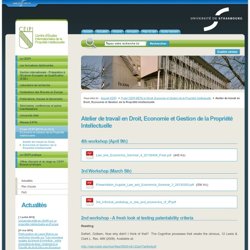
Bureau d’Economie Théorique et Appliquée - UMR 7522 - Travaux de recherche. Patentability of computer software – upheaval in US courts. The patentability of computer software is a hot topic in Australian courts at the moment.
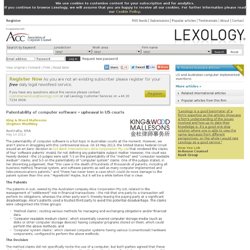
However, we aren’t alone in struggling with this controversial issue. On 10 May 2013, the United States Federal Circuit issued an en banc decision in CLS Bank International v Alice Corporation Pty Ltd that rendered the claims of four ‘software patents’ invalid, for not defining any patentable subject matter. Federal judge determines RAND royalty rate for standards-essential patents in Microsoft-Motorola dispute. In a much-anticipated decision, a federal district court has, for the first time, calculated specific RAND-compliant royalty rates for standards-essential patents.
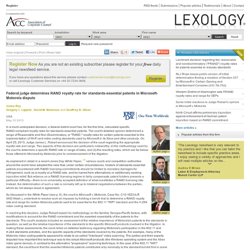
The court's detailed opinion determined a range of Reasonable and Non-Discriminatory, or "RAND," royalty rates for certain patents essential to the implementation of Wi-Fi and video coding standards used by Microsoft in its Xbox and other products. On April 25, 2013, Judge James L. Remedies for the infringement of standard essential patents subject to a FRAND commitment. Following up my posts on Judge Robart’s opinion in Microsoft v.
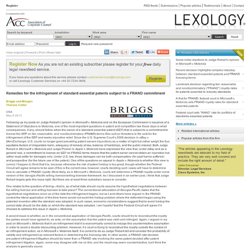
Motorola and on the European Commission’s issuance of a Statement of Objections to Motorola, one of the most important questions in patent and competition law these days is what consequences, if any, should follow when the owner of a standard-essential patent (SEP) that is subject to a commitment to license the SEP on fair, reasonable, and nondiscriminatory (FRAND) terms files suit (or threatens to file suit) for the infringement of the SEP and seeks injunctive relief.
Since the U.S. Supreme Court’s 2006 decision in eBay v. Standards, patents and antitrust: what are the risks? It is important that members of standard setting organisations (SSOs), owners of standard essential patents (SEPs) and licensees of such patents understand the antitrust issues that surround standards and standard setting, as well as the impact of these antitrust issues on the scope and enforcement of intellectual property rights (IPRs).
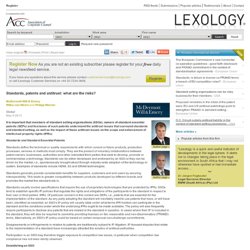
Standards and Standard Essential Patents Standards define the technical or quality requirements with which current or future products, production processes, services or methods must comply. They are the product of voluntary collaborations between patent owners, businesses, authorities and other interested third parties that seek to develop, promote or commercialise a technology. House Judiciary Subcommittee hearing on abusive patent litigation. The House Subcommittee on Courts, Intellectual Property and the Internet has taken an increased interest in the role of non-practicing entities (“NPEs”) in the patent system.

The Subcommittee recently held a hearing on “Abusive Patent Litigation: The Impact on American Innovation & Jobs, and Potential Solutions” on March 14, 2013. During the hearing, members of the Subcommittee expressed their concern regarding NPEs and, in particular, a type of NPEs known as patent assertion entities (“PAEs”). The Chairman and other members of the Subcommittee observed that a growing number of PAEs have been targeting U.S. businesses in abusive patent suits. They noted that PAEs have contributed to a proliferation of poor quality patents. Members of the Subcommittee also acknowledged that a number of changes have been implemented by Congress and the courts to address the issue of PAEs, including the Supreme Court’s 2006 decision in eBay Inc. v. Le rôle économique des « pools » de brevets. REPÈRES Les standards TIC (technologies de l’information et de la communication) sont devenus de plus en plus complexes, jusqu’à se transformer en de larges plates-formes technologiques, comprenant un grand nombre d’inventions brevetées.

Tout industriel souhaitant utiliser un standard dans ses produits doit donc acquérir une licence sur chacun des brevets « essentiels » correspondants – lesquels sont souvent détenus par plusieurs propriétaires différents. Cette multiplication des licences peut brider le déploiement et le succès d’un standard. L’objectif des pools de brevets est d’y remédier, en confiant à l’un des détenteurs de brevet ou à une entité spécialisée le soin de distribuer une licence commune pour l’ensemble des brevets essentiels. La multiplication des accords de licences bilatéraux se traduit tout d’abord par une augmentation des coûts de transaction. Un contrat de licence unique est un moyen efficace de réduire les coûts. Patent wars: EU’s top regulator takes front line position. Essential Patents, FRAND Licensing and Abuse of Market Power There has been a spate of antitrust complaints to the European Commission and other antitrust authorities of late, regarding the licensing of "essential patents".

In the first months of 2012 alone, the European Commission received at least five new antitrust complaints over the potentially abusive use of technology patents. These complaints are being used increasingly by alleged patent infringers as another line of defence against actions brought by patent holders in the United States and in Europe. What does it take to be FRAND? Referral to the CJEU regarding the requirements of the FRAND defense against injunctions based on standard related patents (“SEPs”) - The Düsseldorf Regional Court („Landgericht Düsseldorf“) decided on 21 March 2013 to stay proceedings between China’s two largest telecommunications hardware manufacturers Huawei and ZTE and to refer five questions to the European Court of Justice (ECJ) for a preliminary ruling concerning the availability of remedies (primarily, but not only injunctive relief) to holders of FRAND-pledged SEPs prevailing in patent infringement actions (docket number 4b O 104/12).
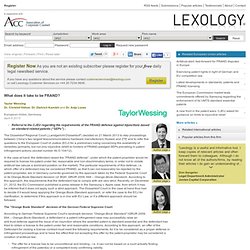
In the case at hand, the defendant raised the “FRAND defense”, under which the patent proprietor would be required to license his patent under fair, reasonable and non-discriminatory terms, in order not to violate antitrust law (abuse a dominant position on the market). The “Orange Book Standard” decision of the German Federal Supreme Court The five questions referred or. Patent Trolls by the Numbers. By Assistant Professor Colleen Chien, Santa Clara University Law School, colleenchien@gmail.com, @colleen_chien (Download PDF of this at SSRN) Following President’s Obama remarks and reintroduction of the SHIELD Act, today the House Judiciary Committee Subcommittee on Courts, Intellectual Property and the Internet is holding hearings on litigation abuse by patent trolls (aka patent assertion entities or PAEs).

Companies J.C. Penney, SAS, Cisco, Johnson & Johnson, & Adobe, are testifying. PAE Comments 04 05 13.pdf. Inventors get small portion of publicly traded patent troll revenues. Boston University School of Law Professors James Bessen and Michael Meurer wrote an insightful article at Patently-O looking at the ten publicly listed patent trolls from 2005 until 2010, including many well known to retailers such as Acacia. Here are some of their findings: Licensing revenues for the six year period was $68B. The mean licensing revenue per defendant was $3.8M, including pre-suit settlements. There was an interesting breakdown by type of troll. Middlemen trolls, such as Acacia that licensure for others made significantly less ($.7M/defendant) than research development trolls ($54M/defendant). Another Interesting Use Of The IP Auction Marketplace. ICAP announced an offer a Covenant Not to Sue (CNS) from MOSAID Technologies during a sealed-bid auction on September 27, 2011.
The CNS covers U.S. patents 5,650,770, 6,198,390, 6,518,889 and 5,963,130, described as “essential to all cellular telephones which implement the Federal Communications Commission’s E-911 emergency call standard.” The patents have been on an interesting ride, including a write-up in the New York Times back in 2009 when they were being offered in a Pluritas patent auction. The article mentions settlements with Qualcomm, Motorola, LG and Samsung. Induced infringement in the United States expanded to include divided infringement. Akamai Technologies, Inc. v. Limelight Networks, Inc. and McKesson Technologies, Inc. v. Epic Systems Corp. Schütz v Werit – Spare part copying. The much anticipated decision of the Supreme Court in Schütz v Werit has now been delivered, and has been followed by the usual frenzy of claims of outright victory and far-reaching consequences. A slighter more considered reading of the judgment reveals a far more nuanced picture and an interesting set of criteria for considering these issues in the future.
Background Schütz is the UK licensee of a patent which protects a specific design of intermediate bulk container (IBC). Joinder practice at PTAB accounts for common patent troll tactic. Joinder Practice Extends Beyond Dissimilar Parties. Le plan du gouvernement pour aider la robotique, Rhône Alpes. EU competition law implications of technology licensing. European Commission Proposes Changes to Its Technology Transfer Block Exemption Regulation and Guidelines The principal rules of EU competition law relating to technology licensing are set out in the European Commission’s Technology Transfer Block Exemption Regulation (“TTBER”) and Guidelines on Technology Transfer Agreements (collectively, the “TTBER/Guidelines”).
The TTBER provides a “block exemption” that shields certain types of agreements from EU antitrust scrutiny, while the Guidelines explain the TTBER and provide additional guidance on the EU competition law analysis of technology transfer agreements that do not fall within the scope of the TTBER. The proposed revisions to the TTBER would, if enacted, subject additional licensing practices to EU review and limit the types of agreements that enjoy safe harbor protection under the existing rules. Brevet, licence et stratégie d'entreprise. REPÈRES La fonction première du brevet est d’assurer la protection d’une innovation technique, protection sans laquelle nombre d’acteurs hésiteraient à investir dans des programmes de recherche et développement. Le brevet accorde à l’inventeur une exclusivité dans l’exploitation du procédé breveté, pendant une durée généralement de vingt ans, pour le pays dans lequel le brevet est valide, et le protège contre la contrefaçon.
Si le détenteur de brevet détecte un tiers contrefacteur, il a la possibilité de lui interdire la poursuite de la production de produits utilisant indûment le procédé protégé. Des entreprises en nombre croissant ont compris qu’il est important de déposer des brevets pour protéger leurs innovations et leurs produits. Celles qui les utilisent pour dégager des revenus additionnels en concédant des licences à des tiers sont en revanche beaucoup moins nombreuses. Center for the Study of the Public Domain. Intellectual Property Watch. Green Patent Blog® Valorizar IP. My Suggestion on Patent Law. It is easy to complain. Much harder to come up with solutions. Many won’t like what I propose, but who wants to make lawyers happy anyway ?
The solution ?